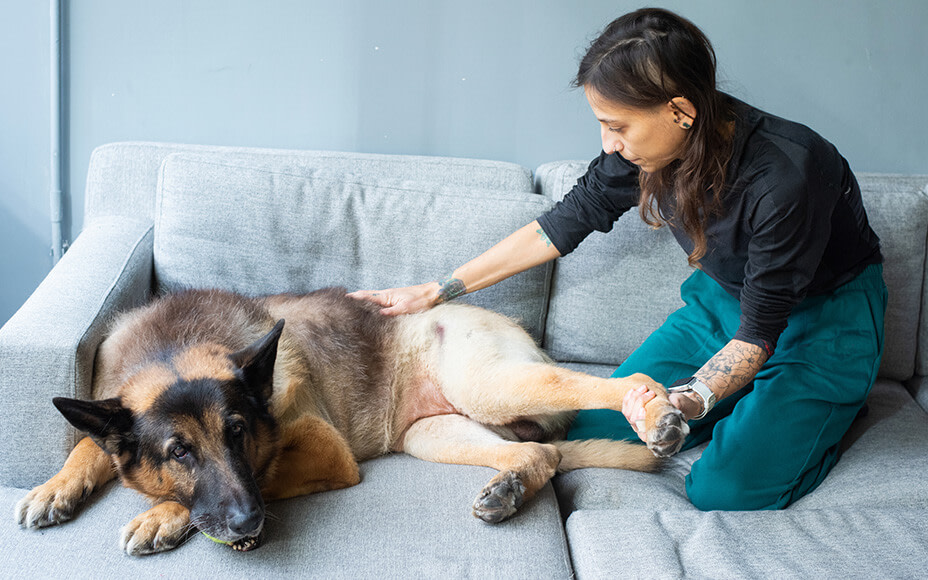How to recognize a stroke in dogs, what are the causes, and how is it treated? Learn more.
- Recognizing and Properly Treating a Stroke in Dogs
- What is a Stroke, and What are the Causes?
- Symptoms: How to Recognize a Stroke in Dogs
- Easily Confused: Vestibular Syndrome
- First Aid Measures When Your Dog Has a Stroke
- Diagnosis and Therapy of a Stroke or Vestibular Syndrome
- Prevention of a Stroke in Dogs
Recognizing and Properly Treating a Stroke in Dogs
A broken leg, a mild stomach upset, and a bit of sniffles are usually things many four-legged friends handle well. But with serious illnesses that affect the brain, like a stroke, every minute counts. In case of an emergency, you should be well-equipped with the necessary information. Learn more about the causes, symptoms, diagnosis, and treatment options for a stroke in dogs.
What is a Stroke, and What are the Causes?
Like us bipeds, the brains of our four-legged companions are supplied with oxygen through the blood. In a stroke, this supply is interrupted because a blood vessel is damaged or a blood clot has formed. As a result, oxygen can no longer be transported. From this point on, nerve cells die continuously, which is why every second is crucial in this condition. If you notice the first signs, your furry friend should be taken to a veterinarian or a clinic immediately.
The cause is a circulatory disorder in the brain. Deposits or clots narrow the path until they eventually completely block it, triggering a stroke. High blood pressure can also injure or rupture an artery, leading to a hemorrhage and stroke. Risk factors that favor a stroke in dogs include:
- Old age
- Obesity
- Lack of exercise
- Heart defects
- Malnutrition (excessive fats, sugar, spices)
- Accident or head injury

Healthy nutrition is not only an important factor for us humans to live a long life. At iHugDogs, we have made it our mission to bring healthy food to every bowl. With fresh meat, crisp fruits and vegetables, select herbs, and rich oils, we strive to create the best meal and provide a dog with a long and healthy life. Unhealthy additives like grains, sugar, and artificial colors and flavors are not found in our products.
Symptoms: How to Recognize a Stroke in Dogs
If you observe the following symptoms in your dog, there might be a stroke, and you should promptly have it checked by your veterinarian:
- Apathy
- Loss of balance
- Weakness
- Restless wandering back and forth
- Impaired vision and uncoordinated movements
- Vomiting and urinating
- Twitching eyes
- Tilting of the body, especially the head
The symptoms are very similar to those in us bipeds – the only difference is that your four-legged friend can’t tell you if they feel strange. Particularly if your dog is a bit older or has pre-existing conditions related to the heart and/or vessels, you should observe them closely.
Easily Confused: Vestibular Syndrome
A stroke is often mistaken for vestibular syndrome. The symptoms are very similar, but the loss of balance is caused by problems in the inner ear. In terms of its effect, the syndrome can be compared to sudden deafness in humans. Although this is very uncomfortable for your dog, it is generally treatable.
If your dog shows symptoms, you should not waste time and go straight to the vet.
First Aid Measures When Your Dog Has a Stroke
With the following measures, you can support your dog until you arrive at the vet:
- Stay calm
- Lay the dog comfortably on its side
- Provide care during the journey

Diagnosis and Therapy of a Stroke or Vestibular Syndrome
In practice, veterinarians will first check whether your furry friend is suffering from a stroke or if vestibular syndrome is causing the symptoms. If a stroke is diagnosed, measures will be taken to clear the blocked vessels. Unfortunately, there is currently no way to restore dead nerve cells, and depending on how much time has passed, paralysis and cognitive impairments may persist. In addition to medications, physiotherapy is often helpful to mobilize paralyzed body parts.
In almost all cases, however, the symptoms are due to vestibular syndrome, which is quickly and effectively treatable. Due to circulatory disorders in the dogs’ balance organ, they exhibit dizziness, vomiting, circling, and staggering. Here, rest is mainly used as a home remedy. Your four-legged friend needs a quiet retreat free from stress and children’s noise, where they can recover. Additionally, medications with cortisone and B vitamins act as circulation-promoting and anti-inflammatory agents. In this case, you should rely on the assessment of veterinarians and, under no circumstances, reach for the home medicine cabinet.
Is your four-legged friend not a fan of the little pills and needs a bit of persuasion? Our liver paste is the best assistant when it comes to making the medication more palatable for your dog!
Prevention of a Stroke in Dogs
To prevent a stroke, the following measures can reduce the risk:
- Adequate exercise
- Healthy nutrition
- Adhere to precise feeding recommendations to avoid obesity
- Avoid prolonged stress


